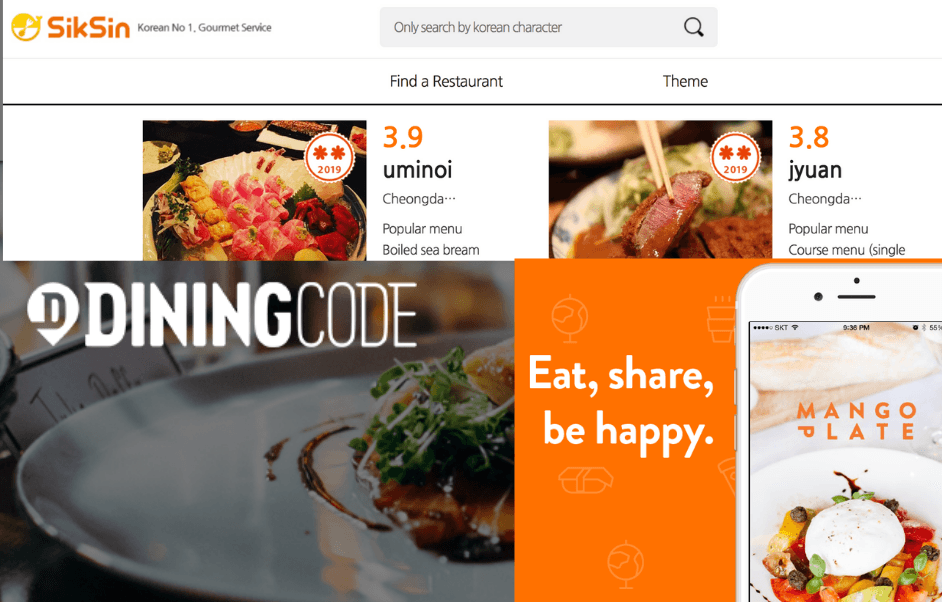If you are visiting South Korea, then you would want to taste the local cuisine, relish amazing food preparations at top class restaurants and enjoy local hospitality. You can easily go to the Korean ‘Google’ version – Naver or check out Daum, which can show you tons of reviews about restaurants in Korea. However, you want to be more tech-savvy and eat at places the Koreans relish then check these Korean startups that can help you find the best place to dine and enjoy Korean hospitality.
1. Catch Table – Catch Table is a real-time restaurant reservation platform introduced by three NHN members, including CEO Yong Tae-soon. Anyone who enjoys gourmet can search for a restaurant of their taste by region, menu, restaurant name, price, etc. In particular, you can easily make a reservation for a restaurant you want by entering the date, time, and a number of people. Catch Table has launched an English version of its app and expects that foreign travelers who visit Korea will easily find great restaurants in Korea using the app, available for download on app stores.
In March 2024, the Seoul Metropolitan Government and Wad, the developer of the Catch Table app, are set to sign a business agreement aimed at facilitating restaurant reservations and virtual queuing for international tourists visiting Seoul. This initiative responds to the growing trend of international visitors coming to South Korea for culinary tourism purposes. According to a survey by the Ministry of Culture, Sports, and Tourism, 68 percent of tourists in 2022 cited culinary tourism as a reason for visiting Korea, up from 61.3 percent in 2019.
2. Dining Code – Dining Code is a technology-based company developing a database for users to enjoy better restaurant services. The app provides authentic reviews of restaurants using big data analysis system. The filtering technology used by Dining Code eliminates blog reviews written for advertisements.
The user can search for a restaurant using their own preferences and the app will come up with the best results regardless of what terms you put in. Dining Code uses various references like user assessment, the number of likes and comments, the blog content and reputation of blogs, etc., to create a fair ranking system. Every reference is meticulously measured and after that, they filter out information that seems incorrect or are advertisements.
Dining Code was launched in 2013 and has investments from Posco Technical Investment, ID Ventures, Seoul Investment Partners, HBIC and Magellan Technical Investment and K Cube Ventures.
3. Siksin – Siksin App is also a growing online-to-offline-based food tech specialty company. Siksin allows users to leave honest feedback on restaurants and recommend places to eat. What makes it different from others is that the app has interesting features like “Easy Booking” where users can make reservations for over 25,000 restaurants by clicking a button and the mobile-friendly electronic meal coupon “Siksin E-Meal Coupon” for office workers. The app can be downloaded for free from Google Play Store, T Store, and Appstore, and is also available from the website.
Siksin, is innovating by integrating metaverse or digital properties into its mobile meal voucher service. Siksin has made significant strides in the metaverse arena, establishing 85,000 metaverse cells across virtual metropolitan areas encompassing Seoul and its outskirts
Siksin, originally founded in 2013 as a restaurant recommendation platform, has experienced significant success with its mobile meal voucher service. This service, utilized by 500 large and medium-sized companies encompassing approximately 150,000 employees in Korea, includes notable clients such as Samsung. The turnover generated from mobile meal vouchers skyrocketed to 75 billion won ($62.6 million) in 2021.
4. MUFKO – In South Korea, where pork is a dietary staple and halal-certified meats are limited, Muslims often encounter inconvenience and difficulty in finding suitable food options and prayer spaces. MUFKO was established in response to the scarcity of halal food options, restaurants, and prayer facilities in a culture where pork consumption prevails. MUFKO sought to address the challenges faced by Muslims living or traveling in Korea. MUFKO aims to create a more inclusive environment for Muslims, fostering greater accessibility and cultural understanding in South Korea.
5. T’order – t’order, is revolutionizing the dining and service industries with its innovative table ordering service in South Korea. By enabling customers to order and pay without face-to-face contact, t’order addresses labor shortage concerns while enhancing customer satisfaction in restaurants, hotels, sports facilities, and shopping malls.
With over 130,000 units of its tablet menu version services embraced domestically, t’order has become a dominant player in the online tablet ordering platform market. Its corporate value stands at an impressive
150 billion won, reflecting its rapid growth and market recognition. The technology behind t’order streamlines operations and increases efficiency by minimizing human interaction in the ordering process. It ensures remarkable accuracy with improved dish pairings, vivid pictures, and multi-lingual capability, reducing wrong orders and enhancing customer satisfaction.
Teaming up with South Korea’s major telecom giant, KT, t’order integrates KT’s service robots with its tablet technology, offering an unparalleled dining experience.
Food Delivery Options in South Korea
If you are not in mood to visit a restaurant, but order in food, then South Korea food tech companies offer the convenience of food delivery. It has become an integral part of daily life in the country, especially for international visitors navigating the culinary landscape. With a plethora of options available, it’s essential to understand the features and coverage of each app to make informed choices. Here’s a breakdown of some of South Korea’s leading food delivery apps:
1. Coupang Eats – Coupang Eats, a rising star among South Korea’s food delivery apps, has swiftly ascended to the ranks of the nation’s leading platforms. The standout feature of Coupang Eats lies in its exceptional delivery speed, with a promise of every order arriving within an impressive 15-20 minutes, eliminating the woes of prolonged waits and hungry stomachs. Users can track deliveries in real-time through the app. One of the most notable advantages of Coupang Eats is its robust English language support, catering to the diverse needs of South Korea’s international community.
2. Yogiyo Food Delivery – Yogiyo Food Delivery stands out as a beacon of convenience in South Korea’s bustling culinary scene. Renowned as one of the nation’s most popular food delivery apps, Yogiyo extends its services across nearly the entirety of the country. While primarily available in Korean, the app also offers a web version accessible to non-Korean speakers.
This inclusive feature enables users to visit the Yogiyo website and utilize tools such as Google Translate to seamlessly translate content into English, ensuring accessibility and ease of use for a diverse user base. With its widespread availability and user-friendly interface, Yogiyo continues to revolutionize the food delivery experience.
3. Baedal Minjok – Baedal Minjok, also known as Baemin, stands as a prominent player in South Korea’s food delivery landscape, boasting an impressive roster of over 140,000 registered restaurants on its platform. In 2019, the food tech startup launched by Korean unicorn company Woowa Brothers Corp, was acquired by German food-delivery company Delivery Hero for $4 billion.Baemin is committed to enhancing the delivery experience through cutting-edge technology. It is working on including the implementation of AI voice ordering technology and the introduction of delivery robots.
4. HungryPanda – HungryPanda emerges as a specialized platform catering to the needs of the Chinese community, particularly in Seoul. With its primary focus on Chinese cuisine, the platform offers an extensive array of dishes, constituting approximately 90% of its offerings. While it features only a handful of renowned fried chicken brands such as BBQ, BHC, and Qijia Chicken, its strength lies in providing a hassle-free avenue for ordering food delivery.
Despite the limited selection of Korean cuisine options, HungryPanda excels in delivering convenience and accessibility to its users. By streamlining the process of food delivery, the platform facilitates seamless transactions, ensuring that customers can enjoy their favorite Chinese dishes from the comfort of their homes without encountering any unnecessary complexities.
Also Read,
- Real-time restaurant reservation service ‘Catch Table’ attracts a $24 million investment
- Woowa Brothers: The Korean food-delivery app business’ journey from being a unicorn to a dynamic global acquisition deal
- Korean startup DamoGO’s app helps reduce food waste by selling ‘unsold’ food from restaurants, stores & farms
- Top Korean startups that offer online grocery shopping
- KFoodtech Inc. Introduces BotBob – a Next Generation Robotic Kitchen Solution for Restaurant Industry
Keep tab on latest news in the Korean startup ecosystem & follow us on LinkedIN, Facebook, and Twitter for more exciting updates and insights.






